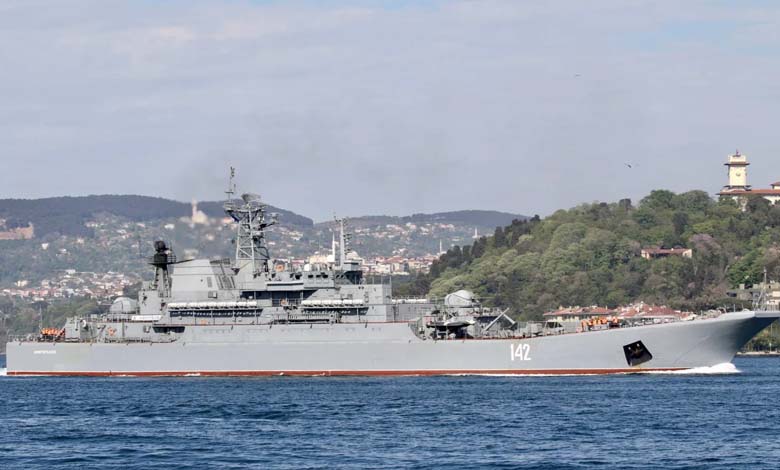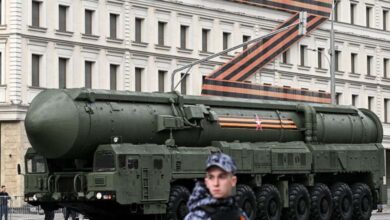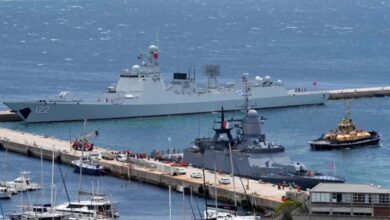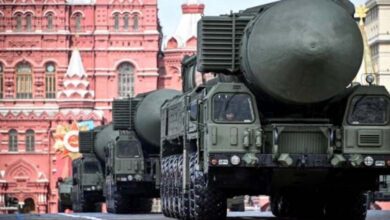Russian Ship Without Radar off Danish Coast: Technical Failure or Military Tactic?

A Russian ship was detected off the Danish coast with its tracking systems switched off, sparking debate over whether this was due to a technical malfunction or a deliberate military maneuver.
-
Massive Russian Attack on Ukraine and NATO Alert in Poland
-
During military drills: the Tsirkon missile appears on the Russian stage
According to Newsweek, this incident coincided with drone intrusions into Danish airspace that targeted sensitive facilities, disrupting both civilian and military air traffic. Copenhagen thus finds itself directly exposed to one of today’s most sophisticated security threats.
The ship, identified as the “Aleksandr Shabalin,” a landing vessel, was spotted near Langeland by a Danish helicopter.
As Newsweek explains, turning off maritime tracking systems is not always a malfunction but rather a common tactic in covert military operations, allowing a vessel to maneuver near territorial waters without being logged by international monitoring systems. This behavior is seen as a show of force and a veiled message from Moscow, signaling that it still has the ability to pressure NATO’s borders despite the war in Ukraine and heavy Western sanctions.
-
On NATO’s Doorstep… A New Russian Facility Raises Western Concerns
-
Russian Advance in Donetsk: The Battlefield Outpaces Diplomacy in Ukraine
Drones add to the confusion
The tensions escalated as unidentified drones entered Danish airspace on two consecutive days, forcing authorities to shut down major airports, most notably Aalborg, which serves both commercial and military purposes.
The drones also approached Skrydstrup Air Base, home to F-16 and F-35 fighter jets, which analysts interpreted as a dangerous attempt not just to disrupt but also to test Western defense readiness at critical points.
An early warning mechanism
In response, Denmark invoked Article 4 of the NATO Treaty, which requires member states to consult when one feels its security or sovereignty is under threat.
This does not amount to Article 5 on collective defense but acts as an alarm bell, opening the door to a joint assessment of the threat and the level of response required. Historically, Article 4 has only been triggered during major crises, highlighting Copenhagen’s sense of urgency.
-
Unexpected Russian Interpretation of Missile Deployment Agreement… A Frightening Outcome
-
Due to Western sanctions: Russian passenger plane crashes, all passengers feared dead
European reactions and rising concerns
Latvia’s Foreign Minister Baiba Braže linked the drone incidents to “state-led activity,” while stressing the need for a more precise assessment before assigning blame.
This reflects Europe’s cautious approach toward Russia, striking a balance between explicit condemnation and avoiding direct escalation. Experts argue, however, that the attacks bear the hallmarks of Russia’s so-called “shadow fleet,” a network of covert tankers used to evade oil sanctions, which could also serve hybrid roles such as surveillance or even drone launches.
A new test for NATO
With Sweden and Finland recently joining, NATO now counts 32 members, strengthening its security perimeter in Northern Europe. Yet what the Alliance describes as “repeated Russian violations,” whether by planes or ships, poses a real test of its deterrence capabilities without sliding into open confrontation.
-
Chaos at Russian Airports and Sleepless Nights in Ukraine… Peace Remains Elusive
-
Ukraine’s Patriot and Russian Sanctions: A Decisive U.S. Move or a Trial of Frontlines?
NATO Secretary General Mark Rutte acknowledged the gravity of the situation, stating on platform X that the Alliance “takes the drone issue very seriously” and that allies are working with Denmark to safeguard critical infrastructure.
Escalation or a new Cold War?
Danish Prime Minister Mette Frederiksen warned that Russia “will remain a threat to Europe and Denmark for years to come,” framing these incidents as part of a long-term strategic confrontation rather than isolated provocations.
Former Lithuanian Foreign Minister Gabrielius Landsbergis went further, warning that the downing of any Russian aircraft in NATO airspace “would go down in history as the spark of a war that began in 2022.” His remarks underscore Baltic fears that hesitation to respond firmly may leave the Alliance exposed to further Russian provocations.
-
Business Insider: Satellite Images Reveal 5 Secret Russian Nuclear Bases
-
Night drones flood Russian skies: Two killed in Lipetsk and Tula
-
Ukrainian Accusations Against China for Supplying Russian Arms Factories… Beijing Responds Sharply
-
Broadcasting the Apocalypse Signal: Mysterious Messages Hint at a Russian Superweapon
-
Russian Invisibility Cloaks: Optical Illusion or Deadly Trap?
-
Putin Invites Arab Leaders to Participate in the First Russian-Arab Summit in October
-
Weapon Tests Precede Russian Official’s Visit… Kim’s Messages to Allies and Enemies












